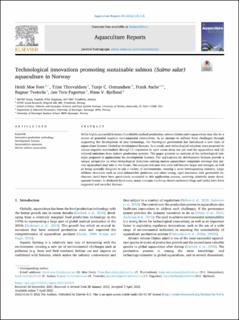| dc.contributor.author | Føre, Heidi Moe | |
| dc.contributor.author | Thorvaldsen, Trine | |
| dc.contributor.author | Osmundsen, Tonje Cecilie | |
| dc.contributor.author | Asche, Frank | |
| dc.contributor.author | Tveterås, Ragnar | |
| dc.contributor.author | Fagertun, Jan Tore | |
| dc.contributor.author | Bjelland, Hans Vanhauwaert | |
| dc.date.accessioned | 2022-08-05T09:02:35Z | |
| dc.date.available | 2022-08-05T09:02:35Z | |
| dc.date.created | 2022-04-22T19:14:34Z | |
| dc.date.issued | 2022 | |
| dc.identifier.citation | Aquaculture Reports. 2022, 24 1-10, 101115. | en_US |
| dc.identifier.issn | 2352-5134 | |
| dc.identifier.uri | https://hdl.handle.net/11250/3010285 | |
| dc.description.abstract | While highly successful in terms of profitable seafood production, salmon (Salmo salar) aquaculture may also be a source of potential negative environmental externalities. In an attempt to address these challenges through supporting the development of new technology, the Norwegian government has introduced a new class of aquaculture licenses labeled as development licenses. As a result, new technological solutions were proposed to reduce negative externalities through (1) expansion to open ocean areas not yet used for aquaculture and (2) reduced emissions from inshore production systems. This paper presents an analysis of the technological concepts proposed in applications for development licenses. The applications for development licenses provide a unique perspective on what technological directions existing marine aquaculture companies envisage that marine aquaculture may take in the future. The analysis indicates that units will become larger and stronger, as well as being specially designed to suit a variety of environments, creating a more heterogeneous industry. Large offshore structures such as semi-submersible platforms and other strong, rigid structures with permeable enclosures (nets) have been particularly successful in this application process, receiving relatively many development licenses. In sheltered fjord areas, many concepts involving closed enclosures (bags and tanks) have been suggested and awarded licenses. | en_US |
| dc.language.iso | eng | en_US |
| dc.publisher | Elsevier | en_US |
| dc.rights | Navngivelse 4.0 Internasjonal | * |
| dc.rights.uri | http://creativecommons.org/licenses/by/4.0/deed.no | * |
| dc.subject | Marine salmon aquaculture | en_US |
| dc.subject | Sustainability measures | en_US |
| dc.subject | Development licenses | en_US |
| dc.subject | Innovative production technology | en_US |
| dc.title | Technological innovations promoting sustainable salmon (Salmo salar) aquaculture in Norway | en_US |
| dc.title.alternative | Technological innovations promoting sustainable salmon (Salmo salar) aquaculture in Norway | en_US |
| dc.type | Peer reviewed | en_US |
| dc.type | Journal article | en_US |
| dc.description.version | publishedVersion | en_US |
| dc.rights.holder | © 2022 The Authors. Published by Elsevier B.V | en_US |
| dc.source.pagenumber | 1-10 | en_US |
| dc.source.volume | 24 | en_US |
| dc.source.journal | Aquaculture Reports | en_US |
| dc.identifier.doi | 10.1016/j.aqrep.2022.101115 | |
| dc.identifier.cristin | 2018521 | |
| dc.relation.project | Norges forskningsråd: 320612 | en_US |
| dc.relation.project | Norges forskningsråd: 301486 | en_US |
| dc.source.articlenumber | 101115 | en_US |
| cristin.ispublished | true | |
| cristin.fulltext | original | |
| cristin.qualitycode | 1 | |

